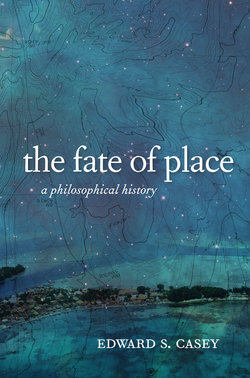Читать книгу The Fate of Place - Edward Casey - Страница 9
На сайте Литреса книга снята с продажи.
ОглавлениеAcknowledgments
The most direct inspiration for this book stems from a graduate seminar I taught at Emory University in the spring of 1992, held under the auspices of the philosophy department and at the instigation of its chairman, David Carr. The intense interest in the history of place that was palpable in that seminar—animated by the keen questioning of the remarkably responsive students who were present—brought home to me the need for a book on the subject. The story of philosophical accounts of place has not yet been told, and I decided (in the wake of my earlier descriptive efforts to discern place more accurately) to tell this story in a comprehensive format. Other graduate seminars substantially aided my efforts: one at the New School for Social Research (1993) and one at the State University of Stony Brook (1994). In each case, my tenative formulations were increasingly refined, thanks to the intense scrutiny of my students. I also presented my views at a week-long seminar on “The Senses of Place” at the School of American Research in Santa Fe, New Mexico, where a number of anthropologists gave me renewed direction and purpose; I especially wish to thank Keith Basso and Steven Feld for their hosting of this event and for the guidance of their pioneering work. I was the beneficiary as well of public audiences when I lectured on the topic, most notably at Vanderbilt University, SUNY at Binghamton, New School for Social Research, Duquesne University, and Yale University.
A number of individuals made essential contributions to my ongoing research into the hidden history of place. Janet Gyatso read many parts of the manuscript and offered invaluable advice, particularly with regard to clarity of argumentation, substance, and style. Without her congenial and warm encouragement, the book might not ever have seen the light of day. The entire manuscript profited from Kurt Wildermuth’s discerning and disciplined look. I also benefited from exchanges with Robert Gooding-Williams, Iris Young, Tom Flynn, David Michael Levin, Elizabeth Behnke, Henry Tylbor, Bruce Wilshire, Glen Mazis, and, especially, Elizabeth Grosz.
My colleagues at Stony Brook were generous in their assistance. Tom Altizer discussed with me my fledgling formulations of mythical accounts of place, and Peter Manchester led me to reconsider my interpretation of the Timaeus. Irene Klaver was of immense help in my treatment of Plato, Husserl, Merleau-Ponty, and Irigaray. I learned a great deal from Lee Miller’s comments on my treatment of medieval figures (especially Nicholas of Cusa), Walter Watson’s close reading of my treatment of Aristotle, Robert Crease’s remarks on my treatment of Leibniz, David Allison’s perusal of the chapter on Descartes, François Raffoul’s and Jeffrey Edwards’s sagacious insights into Kant, and Mary Rawlinson’s rectifying of my discussion of Irigaray. I thank Celian Schoenbach for diligently typing in final changes to the manuscript, and Ann Cahill for preparing the index.
I am grateful to Brenda Casey for help on a number of perplexing points that were evading me even at the end. Constance Casey was an important presence throughout. Consulted at critical moments was Eric Casey, whose knowledge of the languages and cultures of the ancient world proved indispensable to the completion of this book.
James Hillman urged me to pursue place into its most recondite corners so as to convey its story fully and effectively. Conversations with him on aspects of place—particularly its neglected importance in our own time—have been of continuing inspiration. I was fortunate to be so effectively supported in this project by the intelligent, sensitive efforts of Edward Dimendberg, philosophy editor at the University of California Press. He asked me to put this book together in the first place, and he gave me sound direction at every point. To Michelle Nordon of the same institution I am indebted for her caring and responsive supervision of the entire publication process.
